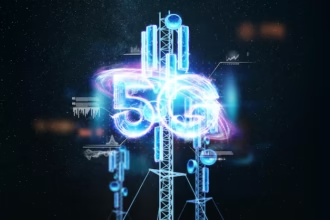Internet of Things refers to physical objects that have connection capabilities, are integrated with sensors and software in order to enable data exchange via the Internet. Such objects can be smart home appliances, smart watches, sensors used in various industries, etc. 5G plays an important role in the benefits of the Internet of Things Services as it will be a game changer for high-speed data transferring, enhanced network capacity, low latency, energy efficiency, and increased device densities, enabling endless opportunities for transformation and innovation across various sectors.
We will be exploring certain benefits of 5G in IOT industry in the upcoming blog.

Top Benefits of 5G
1. Ultra-fast transmission speed
The transmission speed can reach up to 15-20 Gbps. We would be able to access files, programs, or remote applications directly without waiting. The success of IOT is directly proportional to its performance which is highly dependent on how quickly it can communicate with other IOT devices or objects. 5G will enable large data transfer quickly for example in remote monitoring and video surveillance systems.
2. Lower Latency
Response timing is one-tenth of what it was with 4G allowing optimised usage of sensors. IoT devices will be able to communicate with the cloud in very little time, which would be helpful for time-sensitive applications such as self-driving cars and industrial automation. The real-time responsiveness enables endless possibilities for innovative IoT applications, enabling more reliable and autonomous systems.
3. Increased device density
The advanced architecture of the 5G network enables more efficient handling of multiple connections, accommodating a large number of IoT devices per square kilometer, for example by placing sensors in different points and objects in the city, a large part of it can be monitored. If you share the information of the sensors of the cars and those of the city, and these exchange data you can improve the quality of life of the cities, facilitate the navigation of the autonomous car (choose better routes, reduce the number of accidents, find available parking spaces, etc.)
4. Improves Reliability
In addition to the increase in speed, 5G networks will operate more reliably creating more stable connections. Having a reliable and stable network condition is extremely important for any IoT, but especially for connected devices like locks, security cameras, and other monitoring systems that depend on real-time updates. With the ability of a 5G network to handle more connected devices, consumers will benefit from the greater reliability of their connected devices. The high-speed connectivity, very low latency, and greater coverage that will arrive with the next-generation network will be key for IoT devices. To take advantage of these improvements, manufacturers must first invest in building 5G-compatible devices. Manufacturers must equally embrace quality assurance testing to ensure their new devices and software function and perform as intended across various conditions. If not, many new devices will flop as a result of bugs that will reduce the potential gains that 5G has to offer.
5. Network slicing
5G also enables single networks to be divided into multiple virtual networks, or slices, with their own specific characteristics and requirements. These subnetworks are self-contained and can be optimized for specific applications or use cases, such as industrial automation, autonomous vehicles, or remote surgery.
The 5G also allows to implementation of virtual networks (network slicing), create subnets, in order to provide connectivity more adjusted to specific needs.
The creation of subnetworks will give specific characteristics to a part of the network, being a programmable network, and will allow to prioritize connections, as could be the emergencies in front of other users, applying for example different latencies or prioritizing them in the connection to the network so that they can’t be affected by possible overloads of the mobile network.
Use cases of IOT and 5G
5G networks can support a variety of smart city applications, such as traffic management, environmental monitoring, and public safety.
5G’s low latency and high reliability make it ideal for industrial automation applications, such as factory automation, robotic manufacturing, and remote control of heavy machinery.
5G networks can support a variety of healthcare applications, such as remote patient monitoring, telemedicine, and surgical robotics. With 5G, doctors can perform surgeries remotely and monitor patients in real time, allowing for more efficient and effective healthcare.
5G networks can support precision agriculture applications, such as soil monitoring, irrigation management, and livestock tracking. With 5G, farmers can monitor and manage their crops and livestock in real time, allowing for more efficient and sustainable farming practices.
Conclusion
As 5G networks continue to advance, we are on the verge of a connected future where IoT applications are propelling us into a smarter and more responsive era. Currently, the world has over fourteen billion IoT devices. These devices have a significant impact on our economy. The IOT applications and use cases you read above have improved the standard of living. Home automation gives people more time to focus on their jobs. They can do chores quickly. For example, consider an automatic vacuum cleaner programmed to clean houses at a specific interval. People no longer have to spend their valuable time doing that. That can make them more productive.
As mentioned above, the automation of production lines using private 5G IoT networks can improve productivity and reduce costs. That will make commodities cheaper, impacting the economy.







